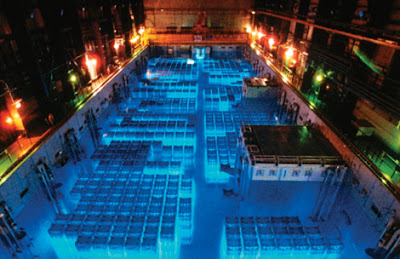One of the biggest things to understand about the challenge of keeping the reactors at Fukushima cool right now is the nature of the challenge. Keeping the reactors cool right now is a matter of keeping up with the decay heat in the fuel. Fortunately, this is a problem that gets easier with time.
When the earthquake struck, each of the Fukushima units was immediately shutdown by a rapid insertion of control rods into the reactor - called a "SCRAM". This brings the fission chain reaction to an immediate halt by depriving the reactor of the necessary neutrons to create fission - the job of control rods is to control the rate of the reaction by absorbing neutrons. The control rods (or in the case of a BWR like Fukushima, plus-shaped control blades) are raised and lowered in order to lower or raise the number of neutrons being absorbed by control rods (rather than the fuel), subsequently controlling the reaction rate and thus the reactor power.
When the control rods are fully dropped in a SCRAM event, the fission chain reaction is fully "off." However, because of short-lived radioisotopes in the fuel, a lot of heat energy remains - this is what is called decay heat. Much of this decay heat lasts for only a short period of time - a matter of days. However, when the reactor is first turned off, the reactor can still have a significant fraction of the full power heating - around 6-7%.
My colleague Alan created a relatively high-fidelity model based on standard techniques used to calculate decay heat, which you can see below. Basically, decay heat falls off in a roughly exponential fashion, as the shortest-lived radionuclides quickly begin to decay away into more stable forms.
| A simulation of decay heat (as a fraction of full reactor power) versus time after shutdown, created by my colleague Alan. |
What this means is that keeping up with cooling the reactor becomes progressively easier as time goes on - the biggest challenge in keeping the reactor cool is in the first day or so. After that, decay heat has come down to less than 1% of the original full power - still hot (on the order of 10 MW), but much more manageable.
In fact this process of decay heat continues for a very long time. Once fuel is removed from a reactor, it is generally stored for several years in a spent fuel pool (known as wet storage). These are generally deep pools of water (typically with at least 20 feet or more of water between the top of the fuel assembly and the surface) which are on-site at the reactor.
 |
| Spent fuel in a storage pool (Image source |
Unlike in a reactor itself, water in a spent fuel pool is generally kept at ambient pressures. The water is circulated in order to keep it cool, however the design of such pools allows for other processes like natural circulation to take over if the forced circulation from pumps is lost. Natural circulation takes advantage of the fact that hot fluid tends to rise and cold fluid tends to sink - as a result, water will continue to circulate over the fuel bundle even in the absence of pumps.
This same phenomenon is used in many of the newer reactors being proposed in the United States in the event of a situation like that occurring right now in Japan, where external power to the reactor is lost. In this case, the natural circulation of coolant itself, along with other safety systems (such as gravity-fed auxiliary sources of coolant) can keep the reactor cool without human intervention.
After spending a few years in cooling ponds, spent fuel is cool enough where it can simply be cooled by air circulation alone. It's still hot to the touch, mind you - but only a tiny fraction of the heat of original power at this point. Spent fuel can thus be moved into large concrete casks which are air-cooled in a process called dry storage.
 |
| Dry storage casks at Diablo Canyon site. (Image courtesy of NRC) |
No comments:
Post a Comment